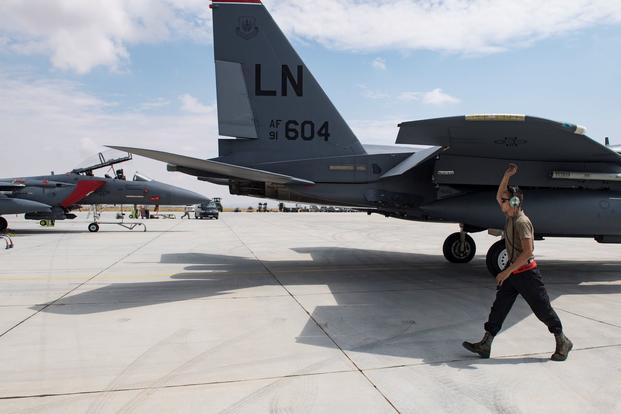U.S. rotational exercises have been on an upswing in Europe since Russia's occupation of eastern Ukraine and annexation of Crimea in 2014. While exercises have always been essential to the U.S. Air Forces Europe-Africa fabric, in an era of "great power competition," service members shouldn't consider a regional deployment as a homework assignment to turn in once they're done, USAFE's deputy commander said recently. Instead, he said, troops should think about each decision, maneuver and relationship as fitting into a broader framework of fighting as an alliance.
"Take the time to look at how [U.S. allies] do operations and what can we actually learn from them," Air Force Lt. Gen. Steven Basham said. Basham sat down with Military.com during the Paris Air Show last week. "At the same time, don't be afraid to critically analyze, ask those tough questions and say, 'Why do we do it this way?'"
The Pentagon has for several years used rotational deployments to Europe as a deterrent to Russian aggression in the region. That's been helped in part by the European Deterrence Initiative. The EDI, prompted in 2014 as a result of Crimea's annexation and originally called the European Reassurance Initiative, has helped the Pentagon in its ambitious outreach to partners in Europe through naval, ground and aerial events.
Related content:
- Air Crews Can Expect Busy Training Year in Europe: General
- Air Force Slowly Building Up in Eastern Europe: USAFE Commander
- Beyond BRRRT: Airpower Alone Won't Secure Victory, Goldfein Says
USAFE earlier this month wrapped up its exercise Astral Knight, which integrated U.S. Air Force F-35 Joint Strike Fighters with the Italians' F-35As for the first time. The Air Force also sent F-15E Strike Eagles from Royal Air Force Lakenheath, England, to take part in exercise Anatolian Eagle in Turkey. The two-week long exercise will conclude this week.
But prepositioning forces "is not always enough," Basham said.
"You actually have to have rotational forces that are always coming through," he said. "There is no substitute for actually coming forward and spending time, not only in the air, but [on] the ground, and working with your allies, working with your partners, understanding the aspects of the airspace. It's no different than any other terrain, but at the same time, it's not just bringing the assets forward."
Basham cited a concept championed Air Force Chief of Staff Gen. David Goldfein: that the future of war is about a network.
"How can we build up the architecture inside Europe and Africa so that we have the network capability, the data links, that are required to do command and control at all levels?" Basham said. "And how do you do that on a day-to-day basis? We should not build an architecture just for an exercise. We should build an architecture and have a roadmap for that architecture that allows us to operate on a day-to-day basis with our sister services as well as with the ally and partner nations."
Basham gave the example of the Joint Range Extension (JRE) pronounced "Jay-ree," which was used during the recent Arctic Challenge exercise in the high-north Nordic countries. JRE, according to the service, is a data link gateway system for long-distance communications, receiving information transmitted on a tactical data link in a particular operational area and then forwarding that information to another tactical data link beyond the line of sight.
"Those [capabilities] are actually extremely, extremely valuable," he said. "The challenge we run into all the time is ... we use those during an exercise, and then we turn around and either we stop using those, [and] we'll turn around and take it right back."
The general argued that, if something works and it makes the forces work better together, it shouldn't just be used in limited circumstances.
"To be able to integrate in time and space in a layered defense, having an architecture that's actually in place, is paramount to actually being able to utilize speed and agility" in a mission, he said.
He added, "The way you avoid entering into conflict is making sure that everyone understands that you're actually ready. You're actually extremely capable. That you have the capacity to do [the job]."
The Air Force has been stressing a "networked approach" as a fundamental stepping-stone for future operations, particularly when multiple forces are involved.
However, if a network can be created quickly to enhance operations, it can just as rapidly be impaired by opposing forces.
For example, Norway recently observed an uptick in GPS jamming during exercise Trident Juncture in October, the largest iteration of the drill since 1991.
The Norwegian government in March formally accused Russia, its next-door neighbor, calling the jamming "electronic harassment."
Because of such unforeseen threats, Basham said the Air Force and its partners have to start implementing 'Plan B' solutions.
"We are learning that it all goes down to the command-and-control," he said. "We have to actually figure out how to be resilient ... whether it's a GPS-denied environment or other type of command-and-control capability environment.
"We learn how to operate full-up capability, and then we start to take certain things away. And if nothing else, what it does is it teaches us we can actually operate through that."
Other nations may also have a way of thinking outside the box to solve these critical issues, he said.
"They might actually show us a capability to be able to do command-and-control that we're not necessarily about," Basham said, reiterating his previous comments about network architecture and JRE.
"You can't do that without working closely with the partners. That's the focus."
-- Oriana Pawlyk can be reached at oriana.pawlyk@military.com. Follow her on Twitter at @oriana0214.












